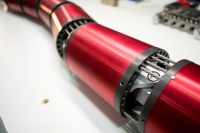By Iain Gray, Chief Executive, Technology Strategy Board
The announcement on 21 October of Britain’s first nuclear power station since Sizewell B heralds a resurgence in this area for UK companies. We already have world-class civil nuclear engineering expertise in this country as well as a proven track record of delivering large and complex projects like the Olympics. Now that we have confirmation of the first in a fleet of new stations, we can strengthen our own industrial base and showcase the UK’s engineering and innovation skills. From this platform, we will be able to go out and win more business across the world.
Nuclear energy has been going through a rocky patch recently, with a number of countries retiring their older reactors. Then of course, there was the disaster in Japan which turned consumer opinion around the world in a more negative direction. So the decision of the UK Government to persevere with this technology represents a bold and ambitious move to embed large-scale, low carbon generation here. To do so, it had to enter into a long term contract for power at a price significantly higher than today’s levels. Only time will tell if the economics work out. But it does make a significant step on the road towards security of supply for the UK.

Much of the focus has been on the investment from France and China. But there will be a substantial input from the UK too. It could be argued that this decision has not come a moment too soon. Those engineers who worked on previous UK nuclear power generation have not been replaced at scale. There are still specialist engineering businesses, of course, but without a home base, the supply chain would inevitably wither – or relocate abroad.
For the Technology Strategy Board, the rebuilding of our supply chain will be a priority. Without a healthy supply chain, there will be no way to bring in the smaller businesses that have so much to offer. It is vital for the future – and not just for nuclear but for engineering more generally – that we nurture new talent and rebuild our expertise in this area.
So, we are developing a funding call to help UK-based businesses take advantage of the opportunities that arise from this and future agreements. We will be looking to support the development of innovative products and services for the primary (Tier 1) suppliers in the civil nuclear supply chain.
The focus will be very much on building a lasting supply chain in this country to service the needs of the industry. This initiative, in particular, aims to establish long-lasting business relationships in key areas such as construction, manufacturing, operation and maintenance.
While this future support will focus primarily on taking advantage of opportunities in the new build sector, it builds on our previous involvement in the sector. Earlier this year, we supported over 30 innovative projects aimed at the existing fleet of nuclear reactors. So the technologies we were looking for were mainly in the areas of life-extension, monitoring, maintenance and decommissioning.
Among the projects that secured funding was one led by OC Robotics (an SME based in Bristol). The project consortium includes NNL, TWI, ULO Optics and Laser Optical Engineering. ‘LaserSnake’ combines two highly innovative technologies – advanced robotics and lasers – to create a safe and cost-effective solution for the multi-million pound nuclear decommissioning market. The project will deliver a robust, re-usable, robot-controlled laser cutting technology that can be applied both in-air and underwater in confined and hazardous spaces to dismantle vessels, support structures, flasks and pipe work.
By bringing small innovative SMEs, as well as research institutions, into the supply chain the UK’s nuclear industry gets access to some of the best new ideas as well as enjoying the fruits of the latest research in this area. All that can feed up to the larger, main contractors and suppliers working in this most specialised of engineering domains.
We would also expect the Nuclear Advanced Manufacturing Research Centre, part of the High Value Manufacturing Catapult, to play a central role in delivering innovation for the UK’s nuclear future.
The negotiations that led to the signature on the Hinkley Point contract were intensive and protracted. But now the deal is in place we can push on to make nuclear engineering capability the envy of the rest of the world.




Swiss geoengineering start-up targets methane removal
No mention whatsoever about the effect of increased methane levels/iron chloride in the ocean on the pH and chemical properties of the ocean - are we...